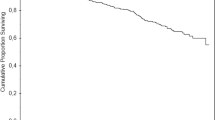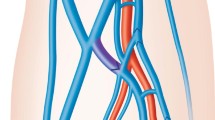Abstract
Purpose
To report the long-term outcomes of bovine ureter grafts as novel conduits for haemodialysis fistulas.
Materials and Methods
Thirty-five patients underwent placement of a total of 40 SynerGraft 100 (SG100; CryoLife Europa®, Guildford, UK) bovine ureter grafts between April 2002 and February 2009. Prospective data were collected on all patients, including active surveillance with blood flow studies and 6-monthly duplex ultrasound studies. Main outcome measures were primary and secondary patency rates.
Results
Mean follow-up time was 97 weeks (range 4–270). Thirteen patients died from unrelated causes during the study period; 12 of these patients had a functioning graft at the time of death. Five patients underwent transplantation, and all had a functioning graft at transplantation. Twelve patients had a functioning graft at the end of the study period. One hundred and ten stenoses were detected, and 97 venoplasty procedures were performed. Of the stenoses, 41.8% were located at the venous anastomosis, 12.7% within the graft, 17.3% in the outflow veins, and 28.1% in central veins. No arterial stenoses were detected. Primary patency rates were 53% at 6 months and 14% at 1 year. Secondary patency rates were 81% at 6 months, 75% at 1 year, and 56% at 2 years.
Conclusions
Active surveillance and intervention was able to achieve satisfactory long-term secondary patency for these novel conduits compared with those made of PTFE seen in other studies [1].




Similar content being viewed by others
References
Chemla ES, Morsy M (2009) Randomized clinical trial comparing decellularized bovine ureter with expanded polytetrafluoroethylene for vascular access. Br J Surg 96(1):34–39
Eknoyan G et al (2001) Continuous quality improvement: DOQI becomes K/DOQI and is updated. National kidney foundation’s dialysis outcomes quality initiative. Am J Kidney Dis 37(1):179–194
Hodges TC et al (1997) Longitudinal comparison of dialysis access methods: Risk factors for failure. J Vasc Surg 26(6):1009–1019
Matsuura JH et al (2004) Cellular remodeling of depopulated bovine ureter used as an arteriovenous graft in the canine model. J Am Coll Surg 198(5):778–783
Sidawy AN et al (2002) Recommended standards for reports dealing with arteriovenous hemodialysis accesses. J Vasc Surg 35(3):603–610
Huijbregts JT et al (2008) Hemodialysis arteriovenous fistula patency revisited: Results of a prospective, multicenter initiative. Clin J Am Soc Nephrol 3:714–719
Widmer MK et al (2004) Intermediate outcome and risk factor assessment of bovine vascular heterografts used as AV-fistulas for hemodialysis access. Eur J Vasc Endovasc Surg 27(6):660–665
Huber TS et al (2003) Patency of autogenous and polytetrafluoroethylene upper extremity arteriovenous hemodialysis accesses: a systematic review. J Vasc Surg 38(5):1005–1011
Rajan DK et al (2004) Dysfunctional autogenous hemodialysis fistulas: Outcomes after angioplasty–are there clinical predictors of patency? Radiology 232(2):508–515
Field PL (2003) The chemically treated bovine ureter―clinical performance of a novel biological vascular prosthesis. Cardiovasc Surg 11(1):30–34
Garvin PJ, Castaneda MA, Codd JE (1982) Etiology and management of bovine graft aneurysms. Arch Surg 117(3):281–284
Nakata Y et al (1982) Late changes in a bovine graft―a case report. Jpn J Surg 12(5):368–371
Asif A et al (2005) Inflow stenosis in arteriovenous fistulas and grafts: A multicenter, prospective study. Kidney Int 67(5):1986–1992
Warakaulle DR et al (2007) Diagnostic imaging of and radiologic intervention for bovine ureter grafts used as a novel conduit for hemodialysis fistulas. AJR Am J Roentgenol 188(3):641–646
Conflict of interest
None
Author information
Authors and Affiliations
Corresponding author
Rights and permissions
About this article
Cite this article
Das, N., Bratby, M.J., Shrivastava, V. et al. Results of a Seven-Year, Single-Centre Experience of the Long-Term Outcomes of Bovine Ureter Grafts Used as Novel Conduits for Haemodialysis Fistulas. Cardiovasc Intervent Radiol 34, 958–963 (2011). https://doi.org/10.1007/s00270-011-0096-z
Received:
Accepted:
Published:
Issue Date:
DOI: https://doi.org/10.1007/s00270-011-0096-z




